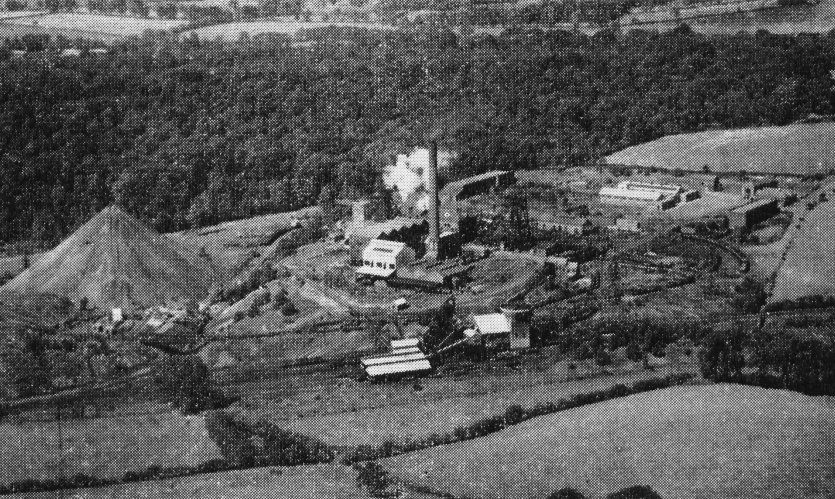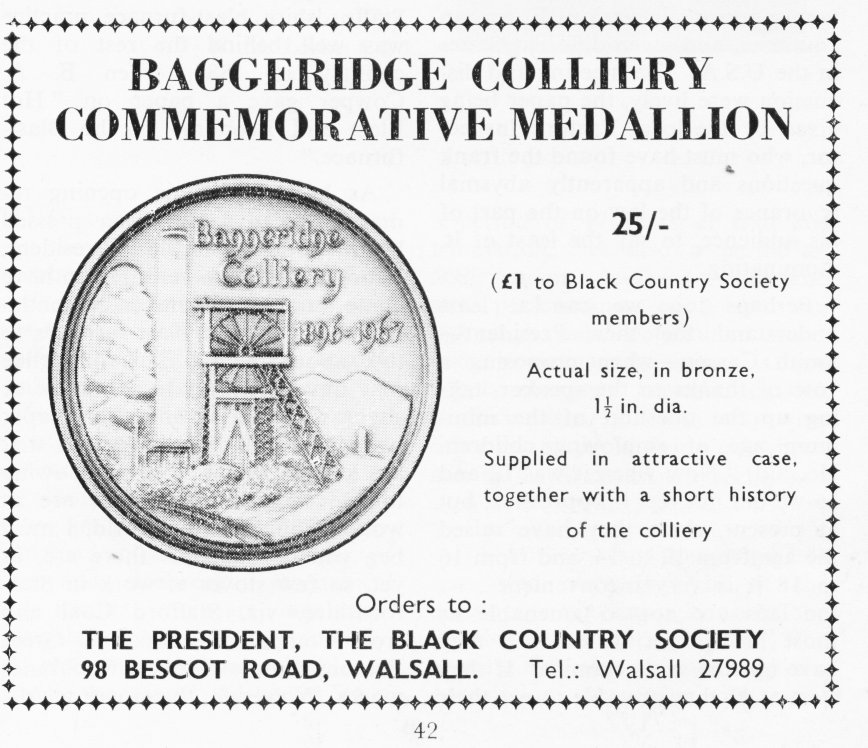The
Sinking of Baggeridge Colliery
(The
'Mighty Financial Undertaking')
Taken from the article of the same name by Richard
Newnham
The Blackcountryman volume 1 Issue 1
In the early years of the nineteenth century the rich mineral
resources of the Black Country had been described as 'inexhaustible'.
As industry intensified, increasing demands for coal and iron
led to a more vigorous exploration of the coalfield. The ease
of mining the coal and the richness of the seams led to much wasteful
mining. Up to 1/3 of the coal was often left in the ground, slack
and small coal was rarely used. Such mining produced a large number
of small pits, often working for only a few years. This led to
abandoned workings that were left to fill with water, forming
vast underground lakes, always a hazard to miners working and
unexpectedly breaking into these caverns.
 Baggeridge Colliery as seen from the air
Baggeridge Colliery as seen from the air
For many years flooding halted work in many Black Country pits.
The richest seams themselves had been worked out. Consequently,
writers toward the close of the century began to talk of a time
when the mining of coal in the Black Country would cease. With
this, it is said, the industrial development of the area would
be permanently damaged.
The Black Country coalfield is bounded on the east and west by
two faults. Between them the various seams of coal often come
together, divided only by thin beds of share or 'partings' to
form the famous 'thick coal'. Where this occurs, the thickness
of the coal can exceed 30 feet.
Mining engineers had already investigated the possibility of
the existence of coal at a much deeper level beyond the eastern
fault. The sinking of Sandwell colliery in West Bromwich and Hamstead
colliery at Great Barr had shown that it was possible to find
coal in this area. In 1895 in a technical paper entitled "The
Mineral Resources of South Staffordshire" Herbert W Hughes,
mining engineer to the Earl of Dudley, forecast that coal would
also be found beyond the western fault. Many geologists, however,
suggested that the coal would lie at such a depth as to make its
discovery impossible without considerable financial investment.
Only Lord Dudley owned a sufficient acreage of ground to undertake
the necessary work to test Mr. Hughes' theory.
The area chosen for the first borings was Baggeridge Wood, a
well known local beauty spot and itself very near to the seat
of the Earl of Dudley at Himley. First experiments in November
1896 were unsuccessful: the bore rods broke, leaving the crown,
containing diamonds then worth £200, in the ground.
Further borings were made some distance away, and the engineers
awaited the result with anxiety. Coal was discovered at a depth
of about 600 yards. This was found to be of a similar nature to
the 'thick' coal and its associated seams known at a much shallower
level in the Black Country itself. In this way Mr. Hughes was
proved right.
The construction of the colliery's first shaft was begun in February
1899, and in July 1902 a seam of coal 24 feet thick was discovered.
A second shaft found the same seam of coal in 1910. This considerable
delay in completing the first works of the colliery was the result
of the sinkers meeting what was described as 'a perfect sea of
water' while sinking the second shaft. For 19 months the workers
fought against the water without making a single inch of progress;
the water was finally kept out by the use of cast-iron segment
plates fixed for 40 yards in the shaft. The principal winding
shaft was 17 feet in diameter and special methods for unloading
the coal involved the use of both German and English technical
ideas.
This attempt to utilise at the pit the most modern machinery
was also illustrated by the equipment used to raise the cages.
10 boilers were used to provide steam for the plant, 4 generating
plants provided electricity that supplied power throughout the
colliery. The colliery was equipped to deal with an output of
3120 tons each 8 hour shift. The winding engines were supplied
by Messrs Frazer and Chalmers of Erith, who had earlier made the
engines for the Sandwell Park Colliery and the compressors at
the Mond Gas Works, Dudley Port.
The total investment over this long period of time before the
pit produced any coal was well described as 'a mighty financial
undertaking'.
While the colliery was being sunk, further work was undertaken
to provide outlets for the coal to be produced. The Great Western
Railway Company and Lord Dudley's private railway built extensions
so that coal could reach Round Oak, The Wallows and other selling
points: a line was built to connect Ashwood Basin to allow canal
boats to receive Baggeridge coal. It was expected that when the
colliery was in full production employment would be available
for 1000 workers.
The sinking of Baggeridge Colliery was to be the last great attempt
to exploit the famous 'thick coal' of the Black Country.
The romantic story of its early days and the tenacity and skill
of those who took part in this work make a fitting end to the
history of pit sinking in the area. Their hopes of finding work
locally for a hundred years have not been realised: their energy
and persistence in undertaking the search for coal at Baggeridge
will not easily be forgotten.
 |
Back in 1968 when Baggeridge Colliery closed the newly
formed Black Country Society issued a special medallion,
1.5" in diameter, in bronze, showing on one side the
head of William, Earl of Dudley, and on the other a view
of the pit-head gear of the colliery.
The medallion came in a case together with a short history
of the colliery.
Only 2000 were struck, each numbered. They were sold for
25 shillings each (£1.25 in decimal currency).
|
The article reproduced above generated a fair amount of interest
in subsequent magazines. In volume 1, issue 2 of The Blackcountryman
a former general manager of the colliery (from 1926 to 1937) put
pen to paper to give an insight. The letter is reproduced below
|
Baggeridge Shafts
The water encountered in the sinking of
the shafts was not held back by iron segments as mentioned
in the article on the Baggeridge Colliery.
Instead of iron segments a special method
of brick lining was put in which the sinkers called "coffering".
This method consisted of building the outer and the inner
courses in the ordinary way with the trowel, these courses
were kept in advance of the middle courses. Into the angular
space was poured liquid cement and the inner courses were
embedded into position.
Had iron segments been installed I should
most certainly have seen them.
I have another very good reason for remembering
this, as my brother, who was apprenticed to one of the Earl
of Dudley's colliery managers, obtained permission to see
the sinkers at work. He took particulars and was able to
answer a question on the subject set for his colliery manager's
certificate of competency, or for his qualification as a
mines inspector, to the satisfaction of the examiner who
asked him if he had any information on "coffering".
Incidentally, there was a third shaft at
Baggeridge sunk to the water-bearing rocks. The South Staffordshire
Waterworks Company installed a steam-driven generator and
an electric pump at the bottom of this shaft, the water
being pumped to the Sedgley reservoir, the colliery taking
their water for steam raising and other purposes. The water
company in addition paid a rate for the metered supply.
When I went to Baggeridge the water company
were not taking any water, as a newly appointed agent had
asked for an increase in the rate. Instead of agreeing to
this the company gave notice to terminate the agreement.
I endeavored to get the company to take the water again
on their own terms, as electric power was being wasted in
running the pump with an artificial head imposed - but they
had made other arrangements.
It seemed to me a great pity to allow such
excellent water to run to waste with only the fish in the
Himley park lakes to appreciate it!
(HD Poole aged 90 in 1968 when this letter
was written)
Joanne Warby
I was wondering if
you have any information on the 25 Year Club for Baggeridge
Bridge. My father in-law Arthur Warby worked there from
1952 until 1977 and I am trying to find out some history
and get some pictures of Baggerridge to add to my story
of his life. He was a fitter. Any help would be greatly
appreciated. Kind regards Joanne Warby.
If anyone
has any information on the "25 year Club" please
email me at the address at the foot of the page. I will
pass on your message to Joanne.
|
Some Useful Links
|
Link
|
Notes
|
Geology
& Extraction History of the Non-Aggregate Mineral Resources
of Staffordshire
David Coxill, SCMC Journal No.3 |
Search for "Baggeridge to find technical
details |
Mining
History Network Bibliography ... The Midlands
|
Self explanatory |
Civilian
Locos 1951 to 1952
{dead link 9 Jan 2012} |
Details of some of the locomotives in use at
Baggeridge |
| Baggeridge
Brick Company History {dead link 9 Jan 2012} |
Baggeridge pit spawned Baggeridge Brick, read
the history |
Warspite
(formerly No. 8 'Sir Robert Peel')
{dead link 9 Jan 2012}
|
One of the engines used at Baggeridge,
a detailed history |
| Gospel
End History - Baggeridge Country Park |
What happened once the colliery
closed, with pictures |
| Jack
Smart's memories of 80 years in Madeley |
A miner who worked for a time at
Baggeridge - his history |
| Penn
Common - by Bev Parker |
History of the area adjacent to
the Baggeridge site |
| Closing
of Baggeridge Colliery |
From Volume 1, Issue 3 The Blackcountryman |
| The Thick
Coal Seams of South Staffordshire |
Taken from article by HD Poole,
General Manager of Baggeridge Colliery from 1926-1937 |
| Mines
Drainage |
Article by B Poole giving information
on the importance of drainage and the use of Newcomen steam
engines to facilitate drainage. |
| Lord Dudley
and the making of the Black Country |
An article by TJ Raybould on how
the Dudley family helped shape the industry in the region. |
| How was coal
formed? Short piece by Bob Hart |
Possibly a controversial theory,
what do you think? |
Mick Pearson 2003
email the web master Mick Pearson:
|


